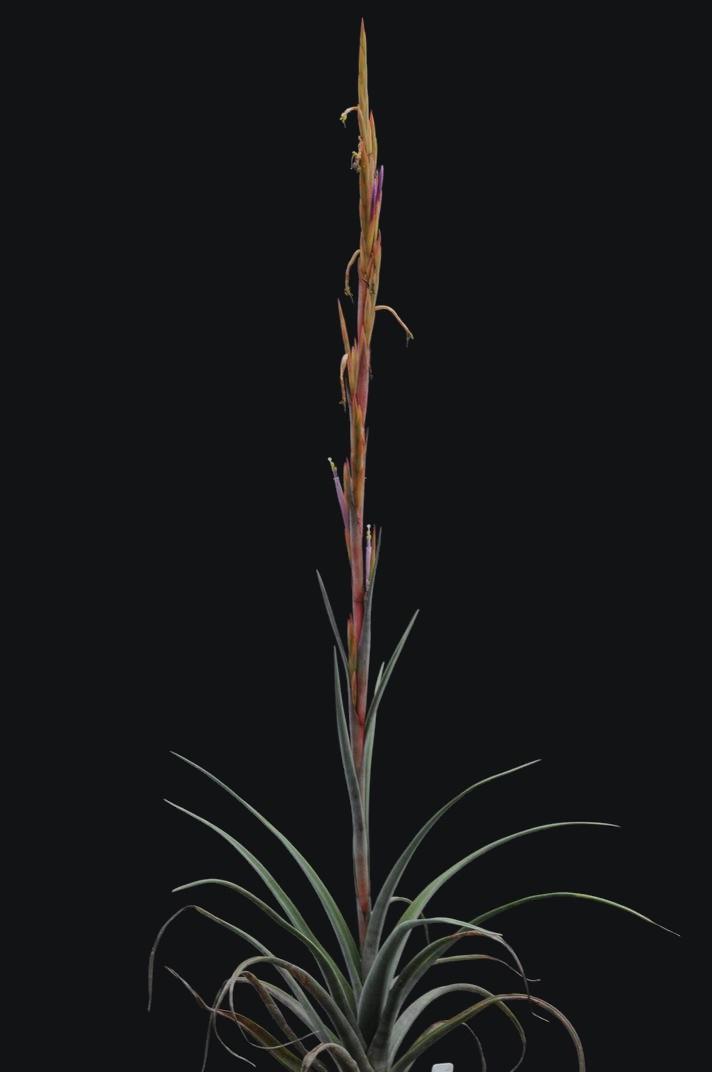
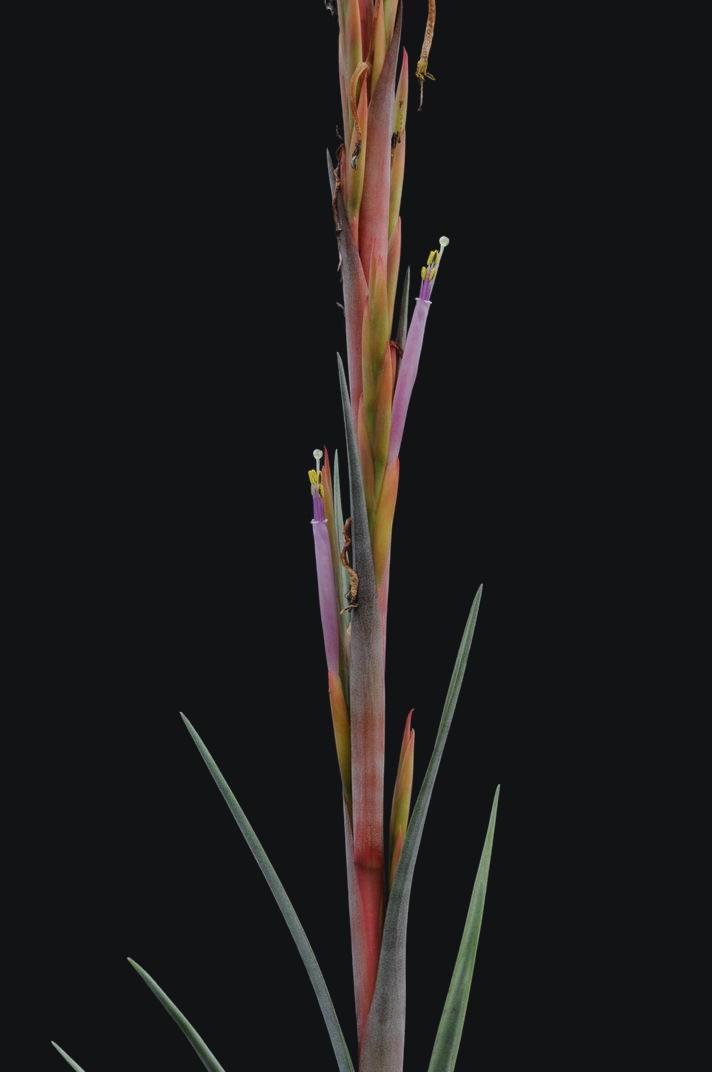
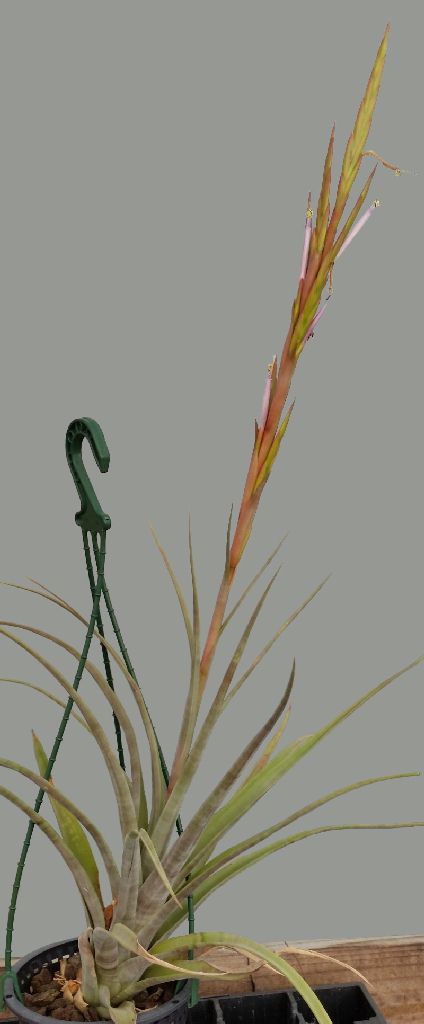
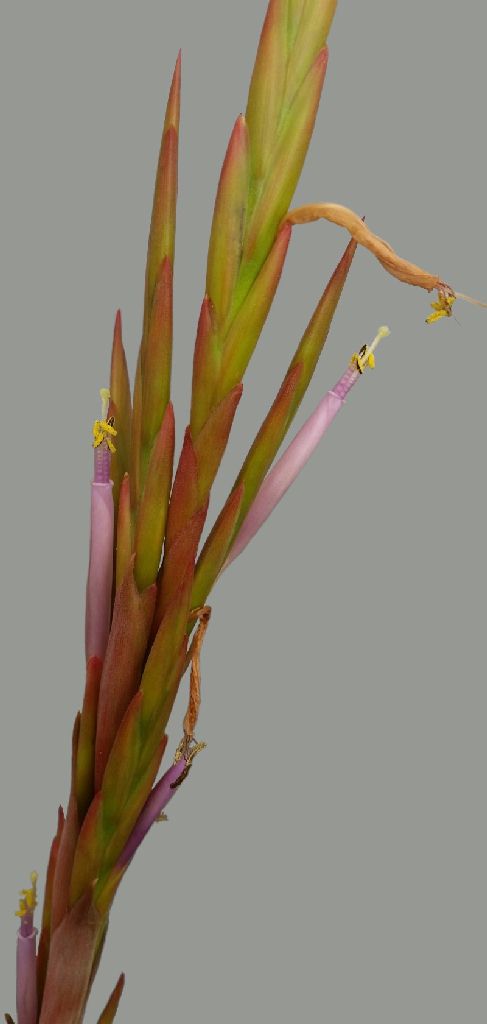
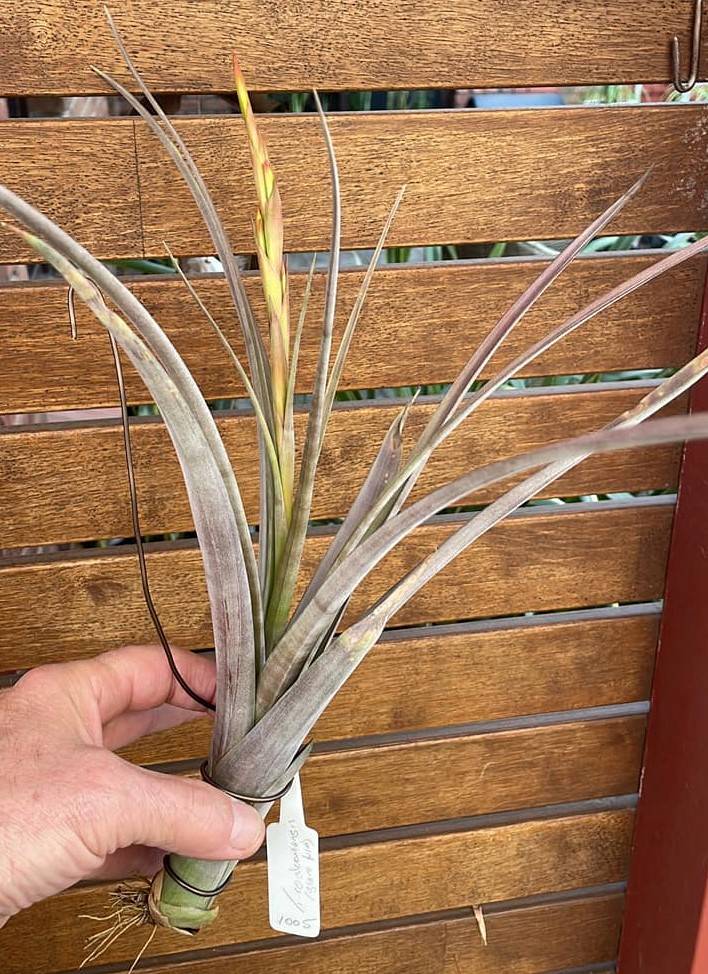
Tillandsia coalcomanensis Ehlers, sp. nov.
A Tillandsia durangensis Rauh & Ehlers vaginis foliorum atroviolaceo-brunneis, laminis supra vaginas 2 cm latis, pedunculo 10-15 cm longo, inflorescentia 6-12 cm longa, 2-3 cm lata, spicis 6-12 cm longis, 1.3- (post florem) 2 cm latis, bracteis florigeris 2.8-3.3 cm longis, sepalis 2.2-2.5 cm longis et petalis 6-6.8 cm longis 10 mm latisque differt.
Typus: Ex cult., cult. et fl. in col. Ehlers, Junio 2006, R. Ehlers s.n. (holo MEXU): Col. in Mexico, Estado Michoacan, in via de Resumidero a Coalcoman, ad locum Punta Telma, 800 m, Decembro 2005, leg. L. & G. Kohres GK9718.
Paratypi: Ex cult., cult. et fl. in col. Kohres, Julio 2006, L. & G. Kohres s.n. (WU). Ex cult., cult. et fl, in col. Ehlers, Maio 2008, R. Ehlers s.n. (WU)
Pflanze auf Felsen, einzeln oder in Gruppen wachsend, fast stammlos, eine aufrechte, schlanke, etwas ausgebreitete Rosette aus wenigen Blattern bildend, 20-35 cm hoch, bluhend 30-50 cm hoch, 35-45 cm im Durchmesser.
Blatter bis 40 cm lang, grun-rot, dicht grau beschuppt, ledrig, etwas sukkulent.
Scheiden undeutlich abgesetzt, his 10 cm lang, 4-5 cm breit, langlich oval, etwas gewolbt, die untere Halfte adaxial braun oder braunrot, sonst gleichfarbig mit den Spreiten, beiderseits klein angedruckt, grau beschuppt.
Spreiten uber der Scheide ca. 2 cm breit, his 30 cm lang, schmal dreieckig, lang zugespitzt, nach aussen geschlagen, die Rander aufgebogen, dicht grau beschuppt, grunrot oder fast dunkelrot erscheinend, abaxial genervt.
Infloreszenzstiel aufrecht; 10-15 cm lang, 5-6 mm dick, dicht imbrikat von den aufrechten, schmal-ovalen Scheiden der wenigen Stielbrakteen bedeckt, die basalen den inneren Rosettenblattern ahnlich, mit langen, schmalen, zuruckgeschlagenen Spreiten, apikal immer mehr verkurzt.
Infloreszenz (fertiler Teil) aufrecht, die Blattrosette uberragend, 8-10 cm lang, 2-3 cm breit, aus 2-6 dicht stehenden, ziemlich aufrechten Ahren zusammengesetzt. Tragblatter viel kurzer als die Ahren, etwa ein Drittel so lang wie diese, den apikalen Stielbrakteen ahnlich.
Ahren 6-12 cm lang, 9-11 mm breit, lanzettlich, abgeflacht, mit sehr kurzem Stiel, locker imbrikat aus 4-11 zweizeilig angeordneten, sitzenden Bluten zusammengesetzt, basal zusatzlich 1-3 sterile Brakteen, Rhachis kantig, abgeflacht, kahl, zur Zeit der Anthese etwas sichtbar, Internodien zwischen den Bluten 10-12 mm lang.
Blutenbrakteen 2.8-3.3 cm lang, 9-10 mm breit, die Sepalen uberragend, oval mit langer, dreieckiger Spitze, ledrig, ungekielt, rot oder rot-grun, kahl, innen etwas genervt.
Sepalen 2.2-2.5 cm lang, 6-6.5 mm breit, schmal-elliptisch, zugespitzt, frei, die adaxialen geflugelt gekielt, dunn-ledrig mit dunnhautigem Rand, grun oder grun-rot.
Petalen 6-6.8 cm lang, im apikalen Teil ca. 10 mm breit, hellviolett, sich basal auf 5 mm verschmalernd und weiss werdend, zungenformig mit etwas Sinuskrummung, eine aufrechte Rohre bildend, die Spitzen kaum nach aussen geschlagen
Staubgefasse weit aus der Blute heraus ragend, Staubfaden 6.5-7 cm lang, gerade, in zwei Kreisen mit unterschiedlicher Lange angeordnet, im apikalen Teil ca. 1 mm breit, im Querschnitt oval, violett, sich nach unten verschmalernd und weiss werdend, Staubbeutel 3-3.5 mm lang, ca. 1 mm breit, ellipsoidisch, an den Enden zugespitzt, nahe der Basis befestigt, hellbraun;
Griffel 6.8-7 mm lang, gleichfarben mit den Staubfaden, Narbe klein, ca. 1.5 mm hoch, ca. 1.5 mm breit, Loben wenig spreizend, fast aufrecht, etwas papillos, grunlich mit lila Hauch, Fruchtknoten 5-7 mm hoch, konisch, an der Basis ca 2.5 mm breit.
Tillandsia coalcomanensis scheint in die Verwandtschaft von T. durangensis Rauh & Ehlers zu gehoren, besonders im nicht bluhenden Zustand zeigen die Einzelpflanzen grosse Ahnlichkeiten. Von T. durangensis unterscheidet sie sich jedoch in den folgenden Merkmalen (Werte fur T. durangensis in Klammern) Pflanze auf Felsen in 800 m Hohe, in heissem Gebiet von Michoacan angesiedelt (in 2000m in Durango); Scheiden der Blatter langer und dunkler braun; Spreiten fiber der Scheide nur 2cm (3.5cm) breit; Infloreszenzstiel viel kiirzer, nur 10-15cm (bis 30cm) lang; fertiler Teil der Infloreszenz kleiner, nur 10-15cm lang und bis 3cm breit (bis 30cm lang und ca. 10cm breit); Ahren kurzer, jedoch breiter, 6-12cm lang und bis 2.5cm breit (bis 30 cm lang und nur ca. 1cm breit); Blutenbrakteen grosser, bis 3.3cm (bis 2.4cm) lang; Sepalen ebenfalls langer, bis 2.5cm (ca. 1.8cm) lang, frei (bis 5mm hoch verwachsen); Petalen viel langer und breiter, bis 6.8cm lang und 10mm breit (bis 4.3cm lang und ca. 4mm breit); Staubgefasse ebenfalls langer.
Translated by Butcher
Plant on rocks, individually or growing in groups, almost stemless, forming an upright, slim, somewhat extended rosette from a few leaves, 20-35cm high, flowering 30-50cm high, 35-45cm in diameter.
Leaves to 40cm long, greenish red, densely grey scaled, leathery, somewhat succulent.
Sheath indistinct, to 10cm long, 4-5cm wide, longish oval, somewhat arched, the lower half adaxial brown or brown-red, normally same colour as blade, both sides with small appressed grey scaled.
Blade above the sheath ca 2cm wide, to 30cm long, narrow triangular, long acuminate, the outer ones bent, the edges bent inwards, dense grey scaled, shiny greenish red or almost dark red, abaxial nerved.
Inflorescence stalk erect; 10-15cm long, 5-6mm thick, densely covered by a few stem bracts imbricately with erect, narrow-oval sheaths, the basal ones similar to the inner rosette-leaves, with long, narrow, bent back blades, apical ones more and more shorter.
Inflorescence (fertile part) erect, exceeding the leaf-rosette, 8-10cm long, 2-3cm wide, with 2-6 dense erect, spikes.
Primary bracts much shorter than the spike, about one third as long, similar to the apical stem bracts.
Spike 6-12cm long, 9-11mm wide, lanceolate, flattened, with very short stem, laxly imbricate with 4-11 double-spaced, sessile flowers, plus 1-3 sterile bracts at the base, Rhachis angular, flattened, glabrous, at anthesis somewhat visible, internodes between the flowers 10-12mm long.
Floral bracts 2.8-3.3cm long, 9-10mm wide, exceeding the sepals, oval with long, triangular tip, leathery, not keeled, red or reddish green, glabrous, inside somewhat nerved.
Sepals 2.2-2.5cm long, 6-6.5mm wide, narrow-elliptic, acute, free, the adaxial wing keeled, thin leathery with thin membranous edge, green or greenish red.
Petals 6-6.8cm long, in the apical part about 10 mm wide, light violet, narrowing to 5mm at the base and becoming white, tongue-shaped with a somewhat bent recess, forming an erect tube, the tips hardly bent outwards
Stamens far exceeding the flower, filaments 6.5-7 cm long, straight, arranged in two circles of different length, in the apical part about 1 mm wide, in cross-section oval, violet, narrowing below and becoming white,
anthers 3-3.5mm long, ca. 1mm wide, ellipsoid, acute at the ends, arrached close to the base, light brown;
style 6.8-7mm long, same colou as the filaments,
stigma small, about 1.5mm high, ca. 1.5mm wide, lobes a little spread, almost erect, somewhat papillose, greenish with a tinge of lilac,
Capsule 5-7mm high, conic, at the base about 2.5mm wide.
Tillandsia coalcomanensis seems related to T. durangensis Rauh & Ehlers, particularly in the non flowering state shows the single plants as largely similar. However it differs from T. durangensis in the following ways, (values for T. durangensis in brackets), plant on rocks to 800m high, found in hot area of Michoacan (at 2000m in Durango); leaf sheaths long and dark brown; Blade above the sheath only 2cm (3.5cm) wide; Inflorescence stem much shorter, only 10-15cm, (to 30cm) long; fertile part of the inflorescence smaller, only 10-15cm long and to 3cm wide, (to 30cm long and about 10cm wide); Spike shorter, however wider, 6-12cm long and to 2.5cm wide (to 30cm long and ca. 1cm wide); Floral bracts large, to 3.3cm,(to 2.4cm) long; Sepals also longer, to 2.5cm, (about 1.8cm) long, free (to 5mm high connate); Petals much longer and broader, to 6.8cm long and 10 mm wide (to 4.3cm long and ca. 4mm wide); Stamens also longer.
Travel report, 9.12.2005
We drove along the Mexican west coast and tried to reach the city of Coalcoman via Aquila several times. Shortly after the drive out to Aquila, interesting limestone rocks appeared and the first tillandsias (T. ionantha and T. caput-medusae) were found there. Upon our first attempts to drive along this road, its condition was so bad that we had to postpone our plan to go from Aquila to Coalcoman.
Upon our third approach in 2005, the road was continuously paved, and we were curious about what we would find. Approaching and leaving Aquila, there were many tillandsias and orchids. Later, the road ascended quickly and led into expanded forest areas. There, Selenicereus validus was found sporadically growing on large trees. In a damp and wet area at El Resumidero, we found T. lauii and T. mooreana on dead trees with their red translucent leaves, as well as Pitcairnia heterophylla ssp. albiflora. Driving in the direction of Coalcoman, we again crossed forested areas.
During a short rest under a tree, Gerhard said: “Look, that cliff over there! It looks interesting". We moved quickly to the other side of the road, and approx. 500 m further, we stood in front of a reddish brown cliff with a steep drop. In the cracks and crevices of the rock grew a Tillandsia that merged strikingly with the colour of the rock, so that we had to look twice to recognise it. After close examination of the plant, we noted that we had not seen such a Tillandsia before. Here at 800m altitude, we found T. fuchsii v. gracilis, T. hintoniana and different orchids on the neighbouring trees. On the ground, Agave maximiliana was growing. So far, this Tillandsia is known only from this rock.
Lydia and Gerhard Kohres Wingertstrasse 33 D-64390 Erzhausen